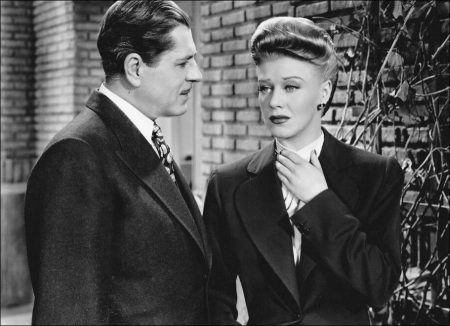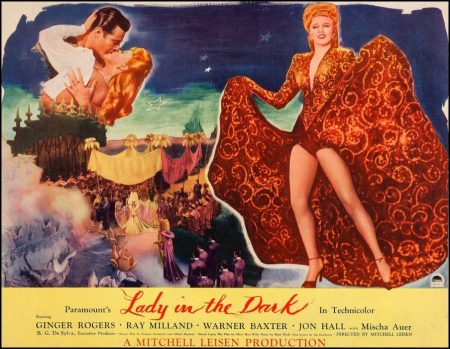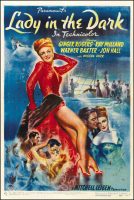Taglines: The minx in mink with a yen for men!
Lady in the Dark movie storyline. The hard-working and successful editor of Allure fashion magazine (decades before The Devil Wears Prada) is portrayed as deeply neurotic. Her physician can find to physical cause for her headaches and refers her to a Freudian analyst. Dreams eventually reveal that she is desperate need of a man to take charge. The story is widely reputed to be the only film ever to show a Freudian analyst seriously, and that may be so, but as a result the movie is far more humorous, in retrospect, than it was ever intended to be. Worth watching for the costumes and music.
Lady in the Dark is a 1944 American Technicolor musical film directed by Mitchell Leisen, from a screenplay by Frances Goodrich and Albert Hackett that is based on the 1941 play of the same name by Moss Hart. The film stars Ginger Rogers as a magazine editor, who although successful, finds herself on the edge of a breakdown while juggling her feelings for three prospective suitors, played by Ray Milland, Warner Baxter, and Jon Hall.
Paramount won the screen rights to the play in February 1941, after a bidding war with Columbia, Warner Bros., and Howard Hughes. The studio initially purchased the play as a vehicle to reunite Rogers with Fred Astaire. However, after negotiations with Astaire failed, the studio cast Milland, who had recently starred with Rogers in Paramount’s The Major and the Minor.
The film was first released on February 10, 1944, and was a critical and commercial success. It was nominated for three Academy Awards; for Best Cinematography, Best Music, and Best Art Direction (Hans Dreier, Raoul Pene Du Bois, Ray Moyer).
About the Story
Liza Elliott (Ginger Rogers) is the successful editor-in-chief of fashion magazine Allure, being published by Kendall Nesbitt (Warner Baxter). Elliott is a no-nonsense workaholic, who is involved in a relationship with Nesbitt. And while the two wish to marry, they cannot, as Kendall’s estranged wife has refused to grant a divorce. Liza has recently developed a series of headaches and strange, bad dreams.
On top of all this, she is having to deal at work with marketing manager Charley Johnson (Ray Milland), who annoys her greatly and takes pride in doing so. She reluctantly sees and undergoes psychoanalysis with Dr. Alex Brooks, who suggests that her no-nonsense approach to life is caused by something from her past, which has made her avoid all attempts at ever being as glamorous as the models in her magazine. Liza discounts this theory, and after Kendall announces his wife has finally agreed to a divorce, she dreams of a wedding to him where she is chased to the top of a large wedding cake where Charley questions whether she wishes to marry him.
Movie star Randy Curtis (Jon Hall) comes to the Allure offices for a photo shoot, where he corners her into accepting a dinner date with him. Anxious about the date, Liza intends to break it off, and storms out of Dr. Brooks’ office when he suggests she is anxious because she is afraid to compete with other women. Charley also informs Liza he will be leaving Allure for another magazine, who has offered more creative rein to him.
Kendall confronts Liza about her fears, and she breaks down and confesses she is confused. To try and sort out her feelings, and aware Curtis does not care about her looks, Liza goes on her date with Curtis, changing into a beautiful dress for a change. The date is ruined when they bump into Charley and his date, who aggressively goes after Randy. She goes home, and hallucinates that she is put on trial by Kendall and Charley at a circus (based on a cover earlier designed by Charley).
After singing about her troubles, she dreams of her father yelling at her for dressing glamorously. In her story to Dr. Brooks, she tells him of this, and possibly the reason for her devotion to a plain style: following her mother’s passing as a young girl, she tried to make him happy by wearing one of her late mother’s glamorous dresses, but was instead scolded, and she became detached from him; another incident happened after her high school graduation, where she went to a dance with a boy she liked, who was stolen away by another girl. Dr. Brooks concludes these incidents contributed to her current life, and suggests she allow herself to open herself to her childhood desires.
Lady in the Dark (1944)
Directed by: Mitchell Leisen
Starring: Ginger Rogers, Ray Milland, Warner Baxter, Virginia Farmer, Barry Sullivan, Mischa Auer, Phyllis Brooks, Mary Philips, Edward Fielding, Marietta Canty, Mary Parker, Catherine Craig
Screenplay by: Frances Goodrich, Albert Hackett
Production Design by: Ed Ralph
Cinematography by: Ray Rennahan
Film Editing by: Alma Macrorie
Costume Design by: Raoul Pene Du Bois, Edith Head, Mitchell Leisen
Set Decoration by: Raoul Pene Du Bois, Ray Moyer
Makeup Department: Wally Westmore
Music by: Robert Emmett Dolan
MPAA Rating: None.
Distributed by: Paramount Pictures
Release Date: February 10, 1944
Views: 207








